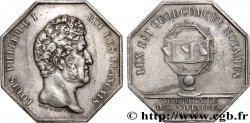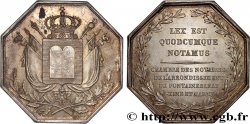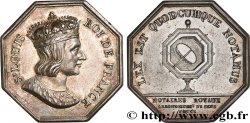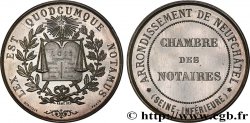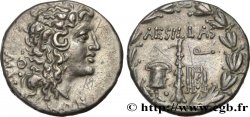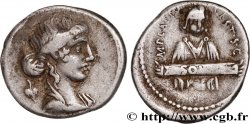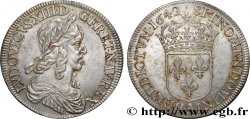Live auction - fjt_207260 - NOTAIRES DU XIXe SIECLE Notaires de Château-Thierry 1806
Sie müssen angeschlossen sein und von cgb.fr genehmigt werden, um in einer E-Auktion teilzunehmen.Melden Sie sich an, um zu wetten..Die Kontobestätigungen sind innerhalb von 48 Stunden nach Ihrer Anmeldung gemacht.Warten Sie nicht bis die letzten zwei Tage vor dem Abschluss eines Verkaufs, um Ihre Registrierung abzuschließen. Klickend "BIETEN" verpflichten Sie sich vertraglich, diesen Artikel zu kaufen und Sie nehmen ohne Reserve die allgemeinen Verkaufsbedingungen für den live auctions zu cgb.fr an.
Der Verkauf wird an der Zeit auf der Übersichtsseite angezeigt geschlossen werden. Angebote, die nach der Schließung Zeit empfangen sind, werden nicht gültig.
Bitte beachten Sie, dass die Fristen für die Einreichung Ihres Angebots auf unsere Server können variieren und es kann zur Ablehnung Ihres Angebots entstehen, wenn es in den letzten Sekunden des Verkaufs gesendet wird. Die Angebote sollen mit ganzer Zahl ausgeführt sein, Sie können Kommas oder des Punktes in Ihrem Angebot nicht erfassen. Bei Fragen klicken Sie hier, um einen Blick auf die FAQ Live-Auktionen.
Alle Gewinngebote unterliegen einem Aufschlag von 18 % für Verkaufskosten.
Alle Gewinngebote unterliegen einem Aufschlag von 18 % für Verkaufskosten.
| Schätzung : | 450 € |
| Preis : | Kein Gebot |
| Höchstgebot : | Kein Gebot |
| Verkaufsende : | 25 Juni 2024 16:55:26 |
Type : Notaires de Château-Thierry
Datum: 1806
Metall : Silber
Durchmesser : 32,50 mm
Stempelstellung : 12 h.
Rand cannelée
Seltenheitsgrad : R2
N° im Nachschlagewerk :
Vorderseite
Titulatur der Vorderseite MRS LES NOTRES DE L'ARROND. DE CHATEAU - THIERRY.
Beschreibung Vorderseite Armes royales couronnées sur main de justice et sceptre fleurdelisé croisés, entourées des colliers des Ordres et enveloppées du manteau royal. Signé Tiolier.
Rückseite
Titulatur der Rückseite LEX EST QUODCUMQUE NOTAMUS ; À L'EXERGUE : 1806.
Beschreibung Rückseite Le gnomon avec portrait impérial difformé.
Kommentare
On doit noter, et il est bien visible sur cet exemplaire, que la boule qui surmonte le gnomon portait un portrait de l’empereur qui a été difformé dans le coin. Ce détail aura généralement échappé aux contemporains comme il a échappé à Maître Lerouge, puisqu’il existe deux modèles du jeton pour la Restauration, avec le portrait de l’empereur et le coin modifié pour l’oblitérer.
On peut supposer que la première distribution de jetons se fit avec le revers “au portrait”, que cette incongruité - sous la Restauration - fut remarquée et que les distributions suivantes se firent avec des jetons frappés avec un coin apuré.
La devise "Lex est quodcumque notamus" est une création du père Ménestrier en 1686 pour les secrétaires du roi qui ne s'en sont jamais servi. L'invention fut reprise par les notaires de Paris puis ensuite par les notaires de Province.
It should be noted, and it is clearly visible on this example, that the ball surmounting the gnomon bore a portrait of the emperor that was deformed in the corner. This detail will generally have escaped contemporaries as it escaped Maître Lerouge, since there are two models of the token for the Restoration, with the portrait of the emperor and the die modified to obliterate it. We can assume that the first distribution of tokens was made with the reverse “with the portrait”, that this incongruity - under the Restoration - was noticed and that the following distributions were made with tokens struck with a purified die. The motto \\\"Lex est quodcumque notamus\\\" was a creation of Father Ménestrier in 1686 for the king's secretaries who never used it. The invention was taken up by the notaries of Paris and then by the notaries of the Province
On peut supposer que la première distribution de jetons se fit avec le revers “au portrait”, que cette incongruité - sous la Restauration - fut remarquée et que les distributions suivantes se firent avec des jetons frappés avec un coin apuré.
La devise "Lex est quodcumque notamus" est une création du père Ménestrier en 1686 pour les secrétaires du roi qui ne s'en sont jamais servi. L'invention fut reprise par les notaires de Paris puis ensuite par les notaires de Province.
It should be noted, and it is clearly visible on this example, that the ball surmounting the gnomon bore a portrait of the emperor that was deformed in the corner. This detail will generally have escaped contemporaries as it escaped Maître Lerouge, since there are two models of the token for the Restoration, with the portrait of the emperor and the die modified to obliterate it. We can assume that the first distribution of tokens was made with the reverse “with the portrait”, that this incongruity - under the Restoration - was noticed and that the following distributions were made with tokens struck with a purified die. The motto \\\"Lex est quodcumque notamus\\\" was a creation of Father Ménestrier in 1686 for the king's secretaries who never used it. The invention was taken up by the notaries of Paris and then by the notaries of the Province








 Berichten über einen Fehler
Berichten über einen Fehler Die Seite drucken
Die Seite drucken Teilen meiner Auswahl
Teilen meiner Auswahl Stellen Sie eine Frage
Stellen Sie eine Frage Einlieferung/Verkauf
Einlieferung/Verkauf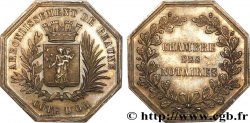
 Details
Details